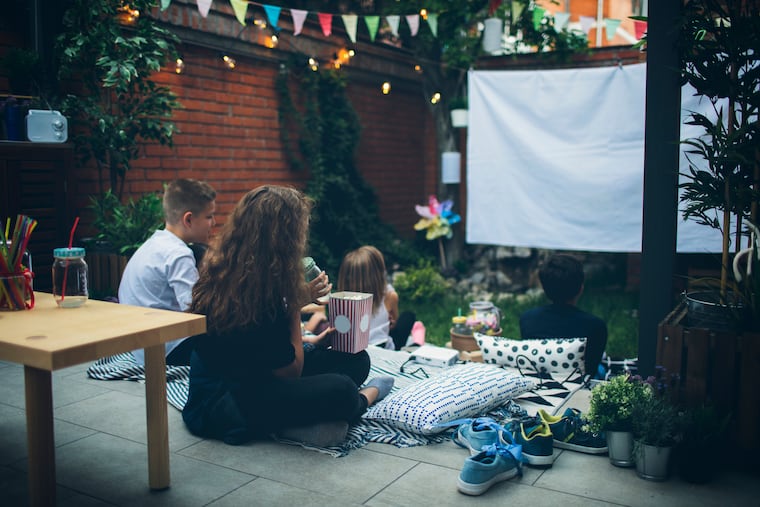How to set up an outdoor home movie theater
But what equipment do you need to set up a backyard movie theater? Here is what you need to know:

Movie theaters have been closed for months in response to the ongoing coronavirus pandemic, and with warm weather in full swing, you may be missing the summer movie-viewing experience.
Sure, you could take a trip to one of Pennsylvania’s many drive-ins to get a taste. Or, with a little planning, you could bring the drive-in home, and a safe trip to the movies may be only as far as your backyard.
But what equipment do you need to set it up? Here is what you need to know:
Will my backyard work for movies?
First and foremost: You need electricity. So make sure you have easy access to power outlets, either outdoors or by running an extension cord from inside. And, of course, make sure there’s no rain in the weather forecast.
Make sure your yard is clean and level so you can easily set up your equipment, and large enough to be comfortable for you and any guests, says Kristen Blasier, rental manager of the Hatboro audiovisual equipment shop Zeo Brothers. If you’re using a projector, you’ll need up to 15 feet of distance between it and your screen, depending on the screen’s size, for a proper picture.
Generally, you’ll be screening your movie in the dark. But make sure your outdoor setup is protected from other bright light sources, such as streetlights or car headlights, which can make the picture harder to see.
What equipment do I need?
If you want the minimum effort: Moving your TV outside for a movie night is an option. If you want to go all out, a little bit of extra technology could provide a more convenient — and more enjoyable — experience. For the full outdoor theater setup, you need a projector, external speakers, and a screen, and the movie player of your choice, such as a DVD or Blu-ray player, Amazon Fire Stick, or laptop.
The picture: Projectors can run anywhere from a few hundred to a few thousand dollars, but there are lots on the lower end that will do the trick. The important things to look for, Blasier says, are lumen rating (or brightness, about 2,500 lumens should cut it), and “keystone” adjustment, which lets you correct the image’s dimension and angle — a helpful tool for less-than-level settings. Gina Izzo, director of marketing at Bryn Mawr Film Institute, says that some newer projectors — like her pick, the Akaso WT50 ($250) — include access to apps like Netflix and Hulu, and Bluetooth connectivity, so you can pair it with speakers.
The sound: You can get away with listening to your projector’s built-in speakers, Izzo says, though using something like a standalone Bluetooth speaker will up the quality — or even headphones, if you only have a few viewers. Most Bluetooth speakers won’t provide the bass-y rumble with which moviegoers are familiar, Blasier says, so connecting a sound system with a subwoofer is a better (though more expensive) option if that’s important to you.
The screen: You can buy a dedicated outdoor movie screen for a couple of hundred bucks. Screens are generally either fixed frame or inflatable, and their surface is more reflective, so your movie looks better. Or you could keep it simple and project your movie onto a light-colored wall or bedsheet strung up to make a makeshift screen (an IKEA clothing rack could work as a frame in a pinch, Izzo says), though the quality won’t be as good.
If all that sounds too complicated or expensive, you might consider renting equipment for your movie night. Some companies, like Zeo Brothers, rent out all the necessary equipment for about $200 for a weekend.
» READ MORE: 12 drive-in movie theaters near Philly
Other movie-night tips:
A note on seating: Sure, you can lounge on blankets while you watch. But that looks better on Instagram than it actually feels, Izzo says. “That’s the worst — you’ll last about half an hour,” she says. “It’s cute, but it gets old fast.”
A better bet: Go with actual seating like lawn or camping chairs to save your back and make movie night as comfortable as possible. If you do go the picnic-blanket route, pillows will give you a little more support.
Keep the snacks simple: No movie night is complete without snacks. But Izzo suggests you stick to foods that won’t attract bugs, which can be distracting — and keep food in a mesh cover tent to keep the bugs at bay. Movie candies like Twizzlers, she says, might be a better option than Goobers or Sno-Caps.
“I think you are OK with popcorn, even with butter,” she says. “Popcorn is a must.”
Be considerate of neighbors: It’s also a good idea to be a good neighbor. Blasier suggests checking noise ordinances in your neighborhood and sticking to them, and making sure your screening is as family-friendly as possible. So be reasonable in your film choice.
“If it’s visible from the road or another person’s yard, I don’t know that I would be showing the Walking Dead or Scream or one of those ax-murder movies outside,” she says. Izzo adds that backyard movie hosts should “read the room” before going ahead with a screening to keep neighbors happy.
Feel free to also invite your neighbors to the screening, but don’t grow the crowd too much. According to the Motion Picture Licensing Corporation, your group needs to be limited to “a normal circle of a family and its social acquaintances” to do right by U.S. copyright law.
» READ MORE: Our best Philly tips: Read our most useful stories